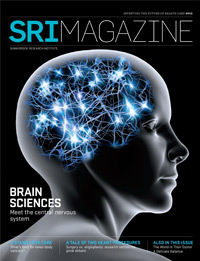- The Fundamentals: Eyes and Ears
- Infrastructure Issues
- Mood Disorders Across Our Lives
- Rhythm of the Night
- Take Three Sardines and Call Me in the Morning
- Spotted
- The MS Cog Fog
- Breaching Barriers
Other Features
- A Tale of Two Heart Procedures
- C Stands for Care
- Coming to an Operating Theatre Near You: 7D Surgical Navigation
Messages
Digest
Short Stories
Connections
- Education & Outreach: The World Is Their Oyster
- Clinical Impact: Lighting the Way
- Ask A Scientist: What Is the Hardest Part About Your Research To Communicate to Someone Without a Scientific Background?
- Partnerships: Collaboration + Expertise = Impact
- Donor Profile: Supporting Excellence
- Facts & Stats: Quick Statistics
- Q&A: Dr. Arjun Sahgal
Ask a Scientist
What Is the Hardest Part About Your Research To Communicate to Someone Without a Scientific Background?
Three scientists at Sunnybrook Research Institute talk about how they talk about their work outside of their natural habitat
Edited by Stephanie Roberts
Dr. Nick Daneman
My research program uses clinical epidemiology and health services research methods to help prevent and treat health care-associated infections. None of this is easy to convey. It’s hard to explain that clinical epidemiology research happens at a desk, and in meetings, and on computers, without the Bunsen burners, pipettes and microscopes of wet lab research. It’s tough to convey how crucial health services research can be when it is not targeting new discovery, but rather, improved use of already available scientific knowledge. The hardest part of all, though, is explaining that the infections I study are not all infectious, that many evolve from a patient’s own bacterial tenants, and that many infections are caused by the very treatments designed to improve health and well-being. So I find it’s better just to call myself an internist. Nobody knows what that means either, but at least they’re not worried I’m contagious.
Dr. Daneman uses hospital- and provincial-level data to optimize prediction, prevention and treatment of hospital-acquired infections. Among his interests are C. difficile, infections of critical care and antibiotic resistance. One recent project entails defining the optimal duration of antibiotic therapy for bloodstream infections.
Dr. Simon Graham
I find that it isn’t the scientific details that are hard to discuss—over time I have developed examples and analogies to discuss my research, and I am enthusiastic about my job. The difficulty has more to do with the social context of the discussion. Speaking to charities, such as the Canadian Cancer Society and the Heart and Stroke Foundation, the environment is very supportive. Typically there aren’t tight time constraints, so communicating is relatively easy. However, I find talking to news media rather nerve-wracking, as it takes a lot of my concentration to deliver a good ‘sound bite.’ I also worry that my words will get taken out of context. Perhaps surprisingly, I find discussing my job at social gatherings to be the most difficult. In some cases, indicating that you are a scientist shuts down the conversation, rather than opening it up. So I take a low-key approach.
Dr. Graham is a neuroimaging scientist exploring the use of functional magnetic resonance imaging (fMRI) for mapping the activity of neurons within the brain. This technology enables noninvasive visualization of how neurons respond in a brain region of interest when doing certain tasks, like thinking or drawing. One project involves studying how to improve fMRI for presurgical planning of brain tumour removal.
Dr. Jonathan Rast
I recently spent time with some non-scientist, college friends who I had not seen for some time, and tried to explain to them what I do. The immediate practical aspects of the work are easy enough to explain. What excites us the most, however, is more subtle. It lies in what we still don’t understand about immunity. We have really just begun to grasp the breadth of animal immune function, and it is increasingly evident that it is about much more than protection from pathogens. Our immune system mediates a half-billion-year-old conversation with the microbes that themselves are part of us. Buried in this wider view of immune function is a universe of unexplored medical possibilities. Our excitement about this less-defined aspect of our work can be difficult to convey, and I’m not sure how well I explained it to my friends. More than ever, though, I think that it is important to keep trying.
Dr. Rast is using purple sea urchin larvae as a simple model in which to study interactions among genes involved in immune response. These interactions are critical in disease, but are difficult to study in humans with their trillions of cells. Using sea urchins is a way to get around that, because they are close relatives of the vertebrates and thus share many genetic traits with humans, but are less complex in terms of morphology.
Photos: Doug Nicholson / Jonathan Rast: Courtesy of Dr. Jonathan Rast



- << Connections |
- Previous: Collaboration + Expertise = Impact •
- Next: Supporting Excellence
- |Through the Wormhole >>






